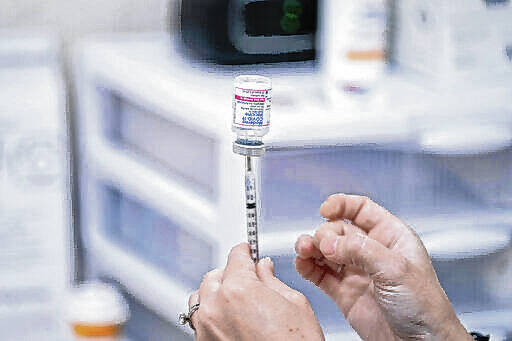
AP Photo/Sean Rayford A pharmacist prepares a dose of the Moderna COVID-19 vaccination for children under five at Walgreens pharmacy Monday, June 20, 2022, in Lexington, S.C. Today marked the first day COVID-19 vaccinations were made available to children under 5 in the United States.
The local effort to get COVID-19 shots into the arms of children as young as 6 months old has still gotten off to a modest start, though state records suggest Bartholomew County parents have been quicker than most to vaccinate their youngest.
So far, 129 of an estimated 5,463 Bartholomew County children under age 5 — about 2.4% — had received their first dose of a COVID-19 vaccine in the three weeks since federal and state health authorities gave the green light for shots for children ages 6 months to 5 years, according to the Indiana Department of Health.
That ranks eighth highest among Indiana’s 92 counties. And it is far higher than neighboring counties where hardly any children in that age group have received their first vaccine dose.
Just eight of the estimated 1,752 Jennings County children younger than 5 had gotten their first dose, or about 0.46%, state records show. In Jackson County, vaccination data was still suppressed on Monday because fewer than five of the estimated 2,878 children in that age group had received their first shot.
Columbus Regional Health officials said they were “pleasantly surprised” to learn that Bartholomew County was ahead of state and national averages but said there is “obviously still work to do.”
“That is encouraging, and we need to applaud the community for their awareness and engagement with getting out there,” said CRH spokeswoman Kelsey DeClue. “…Certainly, we can always do better.”
Similar views were expressed by Bartholomew County Health Officer Dr. Brian Niedbalski, who said he hopes the vaccinations “go up much higher.”
“I’m happy to hear that we have one of the highest vaccination rates in the state for that age group,” Niedbalski said. “I really didn’t have an expectation for a specific percentage, but I hope that our county numbers continue to go up much higher.”
Risks for children
While COVID-19 has been the most dangerous for older adults, younger people, including children, can also get very sick, The Associated Press reported.
The shots offer young children protection from hospitalization, death and possible long-term complications that are still not clearly understood, the CDC’s advisory panel said.
As of Tuesday, 17 children under age 5 were counted among the Indiana’s nearly 23,000 COVID-19 deaths, according to the Indiana Department of Health.
So far, one Bartholomew County child younger under age 5 has died from the virus. Another Bartholomew County child ages 12 to 17 has died from COVID-19, according to state records.
Though most infected children survive, some can develop rare problems after an initial coronavirus infection, including mild and asymptomatic cases, DeClue said.
In rare cases, children have developed heart inflammation or a condition known as multisystem inflammatory syndrome, according to wire reports. That involves fever and inflammation affecting different body parts, among other possible symptoms. Affected kids generally need to be hospitalized but most recover. A similar condition can occur in adults.
“That’s something that people should have in the back of their minds, particularly with children as we continue to see how this virus plays out long-term in people,” DeClue said. “…There’s still a lot of risks out there related long-term to this virus, and the vaccine is very effective at helping our body address those early on, fight those and prevent that.”
“(Children) are not out of the woods with potential complications for heart and lung issues, even if they don’t have a severe COVID infection, and the vaccine has been shown to prevent those as well,” DeClue added.
‘Safe and effective’
Local health officials say the vaccines are safe and effective for children.
In studies, vaccinated youngsters developed levels of virus-fighting antibodies as strong as young adults, suggesting that the kid-size doses protect against coronavirus infections, according to wire reports.
Two doses of Moderna appeared to be only about 40% effective at preventing milder infections at a time when the omicron variant was causing most COVID-19 illnesses. Pfizer presented study information suggesting the company saw 80% with its three shots.
By comparison, the CDC says that the annual flu vaccine is generally 40% to 60% effective.
However, local doctors say they are still seeing hesitance among some parents who question whether their children really need the vaccine, how effective the shots are or are unsure when the best time is to get them, DeClue said.
The CDC and the American Association of Pediatrics recommend COVID-19 vaccinations for all children and adolescents 6 months of age and older who do not have contraindications.
“Talk to your pediatrician because they’re going to know your child’s health. They’re going to know your family’s health and just you can have a conversation. So that’s our first recommendation,” DeClue said. “But secondary, the recommendation from CDC and our and the American Association of Pediatrics, is that when the vaccine is available, go and get it.”
“We’re still seeing the benefits of the vaccine in keeping hospitalizations low, keeping severe infection low even as we go through these continued undulations with the spikes in cases,” DeClue said.
Local hospitalizations
The update from local health officials comes as COVID-19 hospitalizations at Columbus Regional Hospital remained in the double-digits on Thursday.
Over the last week, coronavirus hospitalizations at CRH have hovered between eight and 12, the hospital said. There were 12 people hospitalized with the virus on Wednesday. But that number had ticked down to 10 by Thursday morning, though hospital officials expected that number to increase over the course of the day.
DeClue said there has been a “slight increase” in critical cases, with three COVID-19 patients at CRH being admitted to the ICU over the past four days.
In addition, one new COVID-19 death was reported in Jackson County this past week, raising the county’s total death toll to 129, according to the Indiana Department of Health. A total of 244 people in Bartholomew County and 101 in Jennings County have died from COVID-19.
At the same time, prevalence of the virus in Bartholomew County appears to be at its highest level since the initial omicron surge this past winter, according to CDC wastewater testing data.
The latest data suggests that the concentration was 75% of what it was at the height of the omicron surge this past winter.
Local health officials say wastewater monitoring may paint a more accurate picture of community spread than tests as many people are taking home tests but not reporting the results to health authorities.
“I believe that monitoring wastewater gives us another chunk of data that can be used to monitor activity,” Niedbalski said. “As more people are testing at home, we can no longer rely on the amount of reported cases to assess community spread. We still prefer to focus on the number of hospitalizations.”
“At this juncture, I don’t want to call this a surge,” Niedbalski added. “Perhaps more of a ‘bump’ that we are cautiously watching.”




